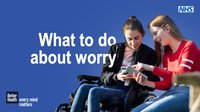What to do about worry – Year 6 lesson plan
Developed with teachers, this lesson supports pupils to identify the different signs of worry, such as thoughts, feelings, physical signs and actions.
Curriculum
Supports the Relationships Education and Health Education statutory guidance
Mental wellbeing
- the benefits of physical exercise, time outdoors, community participation, voluntary and service-based activity on mental wellbeing and happiness
- simple self-care techniques, including time spent with friends and family and the benefits of hobbies and interests
- where and how to seek support (including recognising the triggers for seeking support), including who to speak to in school if they are worried about their own or someone else’s mental wellbeing or ability to control their emotions
- that there is a normal range of emotions (e.g. happiness, sadness, anger, fear, surprise, nervousness) and scale of emotions that all humans experience in relation to different experiences and situations
- how to recognise and talk about their emotions, including having a varied vocabulary of words to use when talking about their own and others' feelings
Supports the PSHE curriculum: Core Theme 1 (Health and wellbeing)
- H1 - what positively and negatively affects their physical, mental and emotional health
- H2 - how to make informed choices (including recognising that choices can have positive, neutral and negative consequences) and to begin to understand the concept of a 'balanced lifestyle'
- H6 - to deepen their understanding of good and not so good feelings, to extend their vocabulary to enable them to explain both the range and intensity of their feelings to others
- H7 - to recognise that they may experience conflicting emotions and when they might need to listen to, or overcome these
Learning objectives
After the lesson, pupils will be able to:
- recognise what worry might feel or look like
- describe actions that a person can take if they are worried
- decide which actions might be more or less effective in dealing with worry
Resource details
- Topics: Schools
- Target audience: Students and teachers
- Published: 22 August 2024
- Last updated: 8 August 2024
